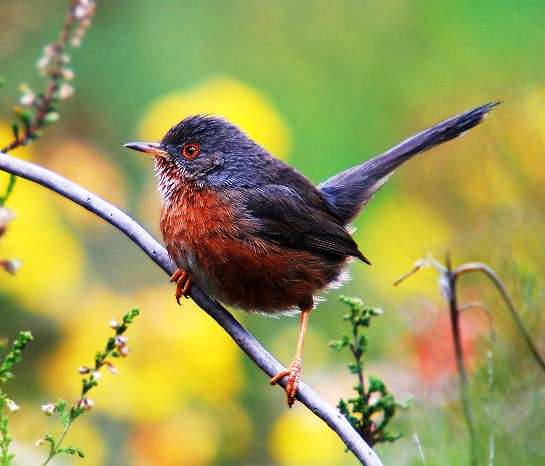Sylvia undata
 |
| Photo by Alberto Maia (Flickr) |
Common name:
Dartford warbler (en); felosa-do-mato (pt); fauvette pitchou (fr); curruca rabilarga (es); Provencegrasmücke (de)
Taxonomy:
Order Passeriformes
Family Sylviidae
Range:
This species has a patchy distribution restricted to southern and western Europe and north-west Africa, being found in Portugal, Spain, Andorra, France, United Kingdom, Italy, Algeria, Tunisia and Morocco.
Size:
These birds are 12-14 cm long and have a wingspan of 14-17 cm. They weigh 9-12 g.
Habitat:
The Dartford warbler is usually found in heathland and open scrubland with scattered trees, favouring areas dominated by Ulex, Erica, Rosmarinus, Genista, Cistus and Quercus coccifera. They are also found in rocky hillsides with thorny maquis, and open woodlands of pine trees with bushy undergrowth.
Diet:
These birds are insectivorous, foraging on several kinds of Coleoptera, Lepidoptera and Diptera and their larvae. During winter, they also feed on spiders, seeds and berries.
Breeding:
Dartford warblers breed in March-July. The nest is built in dense, often evergreen bushes, consisting of a compact cup of grass leaves and stems, and bits of heather, usually with vegetable down, cobwebs, and occasionally feathers. The female lays 3-4 whitish or pale greenish eggs which she mostly incubates alone for 12-14 days. The chicks are cared for by both parents and fledge 10-14 days after hatching. Each pair produces 2-4 broods per season.
Conservation:
IUCN status – NT (Near-Threatened)
Although this species has a large breeding range, it is very patchily distributed. The global population is estimated at 5,7-11 million individuals, but it is declining at a moderately rapid rate, probably by as much as 6% per year. The reasons for this decline are unclear, but they are known to be vulnerable to severe winters, particularly in the northern part of their range. Increasing densities of cattle on Iberian dehesas are causing severe habitat degradation through overgrazing, and afforestation has decreased the amount of suitable habitat in parts of France and Iberia. Changes in the pattern and frequency of wildfires may also be a threat, although the species often colonises early successional habitat created by such fires.







